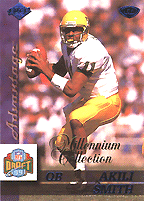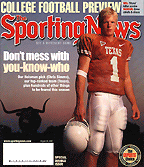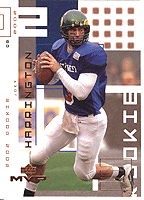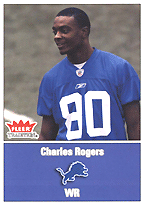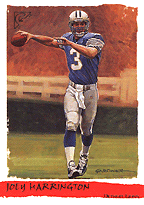![]()
The day Joey Harrington dumped jazz piano as his future career was a great
day for football. The self-styled Joe Montana clone brought the Oregon
Ducks within a downbeat of a national title, then worked a little late-game
magic as a rookie with the Detroit Lions. Though blessed with average
physical tools, Joey knows that, in football as in music, timing is everything.
This is his story…
GROWING UP
John Joseph Harrington was born on October 21, 1978, in Portland, Oregon. The first of John and Valerie Harrington’s three boys—Michael and Nick are his younger brothers—he arrived in the world destined to follow one of two paths: football or music.
Joey’s grandfather on his dad’s side, Bernie, was a Little All-American at the University of Portland in the early 1940s. He loved everything about football, and as he got older and his health failed, the sport became his sanctuary. In fact, he recovered from a bout with colon cancer and a stroke thanks in part to gridiron diversions.
John, a high school principal, inherited his father’s passion for football. A gifted athlete, he played quarterback at the University of Oregon from 1967 to 1969. Just days after learning of Joey’s birth, longtime Ducks coach Len Cassanova jokingly sent a letter of intent to the Harrington home.
Music also coursed through Joey’s veins. He had a great-grandmother who starred on the Vaudeville circuit just after the turn on the century, and someone always seemed to be seated at the piano in his parents’ house. When Joey began banging on the keys at age four, Valerie enrolled him in classical and jazz classes. A year later he was able to sight-read. Soon he started taking Suzuki piano lessons, and later received instruction from the likes of famous jazz pianist Gordon Lee and George Mitchell, Diana Ross’ keyboardist for 20 years.
Religion played a major role in Joey’s life, too. His family’s Irish-Catholic roots extended all the way back to Europe. Grandpa Bernie was a man of unshakable faith, and Joey’s great uncle, Father Emmet, was a priest. Joey learned the value of family, hard work and religion from his father.
When Joey wasn’t practicing on the piano, he was usually outside playing sports. He tried his hand at everything from baseball, basketball and soccer to golf and track. But nothing stirred his passions like football. His father coached at Central Catholic High School, and Joey liked to watch practice from the sidelines. John never pushed his oldest son into football, preferring instead to let Joey’s natural curiosity guide him. Whenever the boy asked to have a catch in the backyard, John gladly made time for him.
Joey got his first
taste of organized football in the fifth grade at All Saints Catholic
Elementary School. John was the team’s coach. The biggest game of
the year was the annual end-of-the-season “Turkey Bowl.”
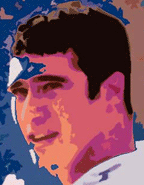
By the time Joey was ready to begin his freshman year at Central Catholic in 1993, it was clear he possessed the innate abilities of a great quarterback. The teenager idolized Joe Montana, first discovering his idol during his days at Notre Dame. In many ways, Joey patterned himself after Super Joe. Like his hero, he didn’t have a particularly strong arm, but he understood the game on a higher level than those around him, and seemed most relaxed and confident when the score was close in the fourth quarter.
Central Catholic coach Terry Summerfield spotted Joey for the first time when he was in the eighth grade. Summerfield asked him to quarterback the scout team one day in practice, and the youngster jumped at the opportunity. The coach knew from then on it was only a matter of time before Joey became the Rams’ starting signal caller.
Earning playing time at Central Catholic was no easy feat. The school, which competed in the Mt. Hood Conference, boasted a proud athletic history, including a total of 17 state championships. Despite starting at the bottom of the depth chart, Joey took over as quarterback for the Rams during his sophomore season.
By his senior year, Joey—who now stood 6-4 and weighed more than 200 pounds—had developed into one of the nation’s top schoolboy passers. In 1996, he threw for 2,151 yards and 28 touchdowns, and was selected as Oregon’s 4A All-State quarterback. SuperPrep ranked him in the Top 10 at his position nationally, while USA Today named him as an honorable mention to its All-American team. (Joey was also an outstanding punter, averaging 44.8 yards per boot, good for second team All-State).
Still, life wasn’t
only about football. Joey formed his own jazz trio at Central Catholic,
playing everything from weddings to bank openings. He also performed the
anthem at his graduation.
ON THE RISE
Throughout his high school days, Joey fixed his sights on playing for Notre Dame. But when the Irish didn’t come knocking, he looked to his father’s alma mater, as well as Stanford. Eventually he decided on Oregon. Not only was the Eugene campus a manageable drive from Portland (which meant his grandfather could attend his home games), but the school’s music program was top-notch.
Joey’s freshman year was spent getting acclimated to being away from home. A Business Administration major, he had no problems in the classroom. On the field, he was redshirted, so his playing time was limited to practice. He learned the offense, watched starter Akili Smith, and began the long climb toward the starting job.
The following season
was also uneventful. Joey appeared in one game in '98, lining up in the
backfield for a halfback pass against USC. Smith took the snap and pitched
the ball to him, but linebacker Chris Claiborne sniffed out the play and
leveled Joey. Weeks later his year ended prematurely when he underwent
surgery to relieve tightness in his right biceps.
Joey’s
first opportunity at serious game action came in the fall of 1999, when
Smith—the ‘98 Pac-10 co-Offensive Player of the Year and the
first pick of the Cincinnati Bengals—departed for the NFL. That
left Joey in a one-on-one battle for the quarterback job with A. J. Feeley.
When the junior had the better training camp, coach Mike Belotti went
with him. Though frustrated, Joey remained upbeat, determined to be prepared
if his number was called.
Feeley started the season with a hot hand, completing 61 percent of his
passes for 1,389 yards and 11 touchdowns in five games. But he struggled
through the first three quarters against Arizona, and Belotti turned to
Joey, who rallied the Ducks with three scoring drives in a wild 44-41
victory. Feeley was back under center the following week versus Arizona
State, but faltered again. In the contest’s final minute, Joey marched
the team 79 yards in 49 seconds for the game-winning touchdown. Belotti
stayed with the sophomore the rest of the way, and Joey responded with
three more victories. He enjoyed his best day against Washington State,
throwing for 239 yards and three touchdowns.
Thanks to their impressive stretch run, the Ducks earned a berth in the Sun Bowl versus Minnesota. Joey was on the mark again, leading Oregon to a 24-20 decision. With a final record of 9-3, the team wound up 18th in the ESPN/USA Today poll. Joey finished with 1,180 and 10 scores through the air, and the second-best passing efficiency (145.5) in the Pac-10.
Despite their victory over the Golden Gophers, the Ducks weren’t expected to do much in the Pac-10 in 2001. Belotti lost nearly every starter on both sides of the ball, including running back Rueben Droughns and linebacker Peter Sirmon. Joey would be charged with piloting an inexperienced offense, while Matt Smith and Rashad Bauman, coming off knee surgery, were the keys on defense. Oregon’s greatest asset was team speed, and the cagey Belotti figured to use it to his advantage whenever possible.
As it turned out, Oregon confounded all the experts. Joey was fabulous from the campaign’s opening kickoff. He averaged 257.6 yards a game in total offense, and doubled his passing production from the previous year. The Football News named him its Offensive Player of the Year, and he was voted second team All Pac-10 (and first team All-Academic), and was a semi-finalist for the Davey O’Brien Award.
The Ducks, meanwhile,
tied for first in the conference, but missed out on the outright title
after dropping the last game of the regular season to hated Oregon State.
Because of that loss, the Ducks found themselves knotted in the standings
with the Beavers and Washington. The Huskies claimed the crown based on
a tiebreaker and went to the Rose Bowl, where they beat Purdue.
More than anything in '01, Joey proved he had the intangibles that define great quarterbacks. Late in the season, with the Ducks trailing by 14 at Arizona State, he engineered two dramatic drives to tie the score. Oregon eventually won the game 56-55 in overtime. In the Culligan Holiday Bowl, the team overcame Texas, 35-30, in a showdown between two of the country’s most dynamic young quarterbacks. Chris Simms of the Longhorns had the more ballyhooed pedigree, but Joey emerged victorious. In the process he became the third player in the Holiday Bowl history to run for a TD, throw for one, and catch a pass for a touchdown.
MAKING HIS MARK
Going into his final season at Oregon, Joey faced a mountain of expectations. One of nine returning starters on offense—including tailback Maurice Morris—he was being counted on to lead the Ducks to the Rose Bowl and the national championship. There was also talk of the Heisman Trophy. In fact, a group of Oregon boosters dished out $250,000 for a 10-story mural of Joey that was plastered on the side of a New York City building, directly across the street from Madison Square Garden. The last Pac-10 player to win the award was USC’s Marcus Allen in 1981, and the Oregon faithful wanted to bring the trophy west of the Rockies once again. Before long people began calling the senior “Joey Heisman.”
Joey tried to ignore the hype and focus on football. In a win against Wisconsin, he passed for 277 yards and two touchdowns, then ran for a third score late in the final period to give Oregon a 31-28 victory. Against Arizona, he accounted for six TDs, three through the air and three on the ground. Joey also rang up six scores against Arizona State, all courtesy of his right arm.
By mid-October, the Ducks were 6-0, and Joey was looking more and more like a legitimate Heisman candidate. With Stanford due in town, the team was in position to make a run at the national title. While Joey sparked the offense once again, Oregon couldn’t stop the Cardinal. The result was a devastating 49-42 defeat. The Ducks and their fans were stunned.
Joey reacted with
an impassioned speech to his teammates, telling them that the season was
far from over. They heard him loud and clear. Several weeks later, down
by six points to UCLA in the fourth quarter, Joey gave the team another
pep talk on the sidelines. He then orchestrated the game-winning drive.
In the annual clash with Oregon State, the Ducks put the finishing touches on their near-perfect regular campaign with a 17-14 victory. Joey wasn’t at his best (11 for 22 for 104 yards), but he didn’t have to be. Atfer his heroics versus the Bruins, the Oregon players were willing to run through a wall for him.
At 9-1 and #2 in the country, Oregon received an invitation to the Fiesta Bowl against Colorado. The Ducks needed help to claim the national championship. Since the BCS rankings favored Miami, Oregon would have to rely on the polls for a share of the crown. To sway the voters, the team would have to post a blowout win over Colorado, then root for the Hurricanes to fall to Nebraska in the Rose Bowl.
Before the tilt against the Buffaloes, Joey joined Eric Crouch, Ken Dorsey and Rex Grossman at the Marriott Marquis Hotel in New York for the Heisman Trophy presentation ceremony. While those close to him were optimistic about his chances, he looked forward to the trip mostly because it enabled him to tour the Big Apple. Joey wasn’t surprised when Crouch got the hardware and he finished fourth in the voting.
When he returned home, Joey shifted his focus back to the Fiesta Bowl. Playing for a shot at the national title was exciting in and of itself, but a full contingent of family and friends was also set to make the trek to Arizona, including Grandpa Bernie. Though ill, he refused to miss Joey’s last college game.
The trip was well worth it. In a 38-16 laugher, Joey completed 28 of 42 passes for 350 yards and four touchdowns, including a 79-yarder to Samie Parker. Unfortunately for the Ducks and their fans, Miami also won big and held on to the top spot in the country.
Joey had little time to reflect on his sparkling college career. With the NFL Draft less than four months away, his thoughts turned to where he was headed as a pro. The expansion Houston Texans held the first pick, but David Carr headed their depth chart. In the second slot, the Carolina Panthers were mesmerized by Julius Peppers. That gave the Detroit Lions a multitude of options. The team needed a quarterback desperately, and Joey seemed like a good fit. Though some questioned his arm strength, Detroit GM Matt Millen liked his mature attitude, understanding of the game and commitment to winning. When Carr and Peppers went 1-2, the Lions quickly tabbed Joey.
The 23-year-old’s excitement was tempered somewhat by personal tragedy. A month earlier, Grandpa Bernie had passed away. His grandfather’s death, however, also bolstered his resolve to succeed in the NFL.
With the Lions, Joey knew the opportunity existed for him to play right away. The club had finished a dismal 2-14 in 2001, and Mike McMahon, a second-year player out of Rutgers, was the incumbent at quarterback. Eager to avoid any distractions, Joey signed a six-year, $36.5 million contract in July.
The team he joined was subpar in virtually every area. Detroit’s top rusher, James Stewart, had gained just 685 yards in ‘01. Their leading receiver (and club MVP), Johnnie Morton, was gone, inking a free-agent deal with the Kansas City Chiefs. One silver lining on offense was the line, which showed signs of gelling behind Jeff Backus and Tony Semple.
On defense, there
were just as many questions. Kurt Schottenheimer was hired to turnaround
a unit that in 2001 had surrendered the most points in the NFL. Along
the front seven, veteran Robert Porcher, mammoth Shaun Rogers and Chris
Claiborne were the leaders. The secondary was probably the weakest part
of the squad.
Training camp was a real learning experience for Joey. Picking up coach Marty Mornhinweg’s system and adjusting to the speed of the pro game was difficult. He saw his first action in Detroit’s preseason opener against the Baltimore Ravens. Joey looked comfortable enough, but threw an interception late in the fourth quarter that was returned 18 yards for the game-winning touchdown.
To no one’s great surprise, Mornhinweg named McMahon his starter coming out of camp. But when the Lions fell in their first two contests, the coach switched gears and promoted Joey to the first string. Though the rookie felt bad for McMahon, he embraced his new role.
The Joey Harrington Era officially began for the Lions on September 21, 2002, against the Green Bay Packers. The day also marked the first regular season game at Ford Field, Detroit’s new domed home.
Mornhinweg pleaded with fans to be cautious in their optimism, but they found it hard to curb their enthusiasm. The Lions battled the Packers until the final gun, losing in a 37-31 shootout. Joey—who connected on two touchdown tosses—drove Detroit deep into Green Bay territory with less than a minute left, but his fourth interception of the afternoon sealed his team’s fate.
The following week, Joey delivered the first victory of his career, a 26-21 thriller over the New Orleans Saints. He completed 20 of 36 passes for 267 yards, a touchdown and no interceptions.
After a bye week, the Lions faced the Minnesota Vikings on the road in the Metrodome. The game started on a positive note—Joey hit Mikheal Ricks with a 41-yard scoring strike—and at halftime, the Lions led 21-10. But the Vikes controlled the contest after intermission and held on for a 31-24 win. Joey rebounded with a good effort the following week, as the Lions registered an overtime victory against the Chicago Bears. In Detroit’s final possession of the fourth quarter, he connected on six of eight passes to set up kicker Jason Hanson’s game-tying field goal.
The next two months provided more ups and downs for Joey and the Lions. A defeat at the hands of the Buffalo Bills was followed by a victory over the Dallas Cowboys. Then came a string of four losses, including a 20-12 downer to the New England Patriots on Thanksgiving Day.
Going into the final four games, Joey was determined to end the year on a positive note. But his season came to a screeching halt when he had to undergo a non-surgical procedure to correct an abnormal heart rhythm known as Supra Ventricular Tachycardia. He first experienced the problem in a game against the Tampa Bay Buccaneers. Joey has since had a catheter inserted into his heart to destroy the tissue causing the condition.
McMahon took over
at quarterback the rest of the way, and the Lions finished at 3-13. Detroit's
poor record overshadowed some good performances. Stewart had a nice year,
rushing for 1,021 yards. Joey’s final statistics weren’t bad
either, including 2,294 yards passing and 12 touchdowns. His interception
total (16) was too high and his quarterback rating (59.9) was too low,
but both numbers were the result of rookie mistakes.
Heading into 2003, all signs indicated that Joey was on his way to stardom, especially with former San Francisco 49ers coach Steve Mariucci assuming the reigns in Detroit. The QB got more good news on draft day when the Lions selected wide receiver Charles Rogers with the #2 pick. The team also tried to strengthen its defense, grabbing linebacker Boss Bailey out of Georgia and signing free-agent cornerback Dre’ Bly.
In the season opener, Joey passed for 195 yards and four touchdowns against the Cardinals in a 42-24 win. Unfortunately for the Detroit signal caller, that contest proved to be the highlight of his campaign. (Unless you count his appearance in the finals of “Monday Night at the Mic,” though Joey and “his band”—John Popper and Blues Traveler—were out-voted by Doug Flutie and Barenaked Ladies.) Over the next two weeks, he was picked off six times, as the Lions fell to the Packers and Vikings. Things got worse in October when Rogers went down for the year with a broken collar bone. Joey had been developing nice chemistry with the rookie. His absence affected the entire offense.
After dropping six straight, Detroit snapped its losing streak with consecutive victories against the lowly Oakland Raiders and Chicago. Then it was back to inconsistent play. The defense—which surrendered 379 points on the year—had difficulty stopping teams with good running attacks, while the Lions themselves struggled to move the ball on the ground. The disparity produced predictable results. Detroit finished at 5-11, last in the NFC North.
The team, however, gave its fans some hope with a surprising 30-20 win at St. Louis to end the campaign. Joey was terrific in that one, hitting on 26 of 36 attempts for 238 yards and three scores.
For the majority fans as well as those in the media, the 2004 campaign was a crucial year for Joey. For the first time in his career, he had a full complement of talent around him on offense. This was due mostly to the Detroit's good work in the draft, where the team added running back Kevin Jones and receiver Roy Williams. Defensively, the Lions also figured to be better, particularly with hulking lineman Shaun Rogers coming into his own.
The season started on a familiar note when Rogers broke his collarbone in the opener at Chicago. But Joey and company perservered, pulling out a 20-16 victory. His touchdown pass to Hakim in the fourth was the difference.
Joey enjoyed an even better day a week later at home against Houston. In a contest billed as a battle between two of the league's promising young quarterbacks—David Carr was the starter for the Texans—Detroit won 28-16. Joey got the best of his counterpart, throwing for three TDs.
The Lions split their next two, including an impressive win at Atlanta. At 4-2, they were one of the NFL's early surprises. No one was predicting a Super Bowl appearance, but in the mediocre NFC, a playoff berth seemed a real possiblity. Joey was riding high, too. He had 10 scoring tosses in his first six games, against only three interceptions.
The season, however, soon collapsed. A five-game losing streak dropped the team's record to 4-7. Joey began to feel the heat after a defeat to the Colts on Thanksgiving Day. With Peyton Manning putting on a clinic in the 41-9 blowout, the home crowd grew restless. When Mariucci inserted Mike McMahon against Indy, rumors circulated that the backup QB might get the chance to start the following week.
Joey's problems were difficult to figure out. After showing great confidence to begin the campaign, he had lapsed into bad habits. With his offensive line struggling at times to protect him, he was dumping the ball to recievers on short routes rather than trying to deliver passes downfield on intermediate and deep patterns. The low point for Joey came in December against the Packers. In a 16-13 loss, he completed just five of 22 attempts for 47 yards.
Ailing with the flu and tired of being knocked by the fans, Joey took matters into his own hands the following week at home against the Vikings. Though the Lions lost a heartbreaker, 28-27, he earned respect for his gutty performance. With Detroit trailing by a touchdown late in the game, Joey engineered a long scoring drive cluminated by a TD toss to Williams. Incredibly, however, Detroit muffed the extra-point and went home losers.
A rejuvenated Joey
ended the campaign on a high note, producing a victory over the Bears
and then passing for 346 yards and two touchdowns in a loss at Tennessee.
The Lions wound up at 6-10, nowhere near the playoffs, but a game better
than the pervious year. Joey also improved his numbers. His yards passing
(3,047), TDs (19) and QB rating (77.5) all represented career-highs. He
cut down on his turnovers, too, throwing just 12 INTs.
Still, fans in Detroit can't but help to wonder about their young quarterback. Is the real Joey the guy who looked confused and helpless against an often porous Indianapolis defense or the guy who tore up equally defensively-challenged Minnesota? Some critics believe his mistakes are a harbinger of things to come. The flip side is that Joey—who endured another year of hard hits without much complaint—is now poised to become a true star.
In the end, Mariucci may end up making the biggest difference. A proven winner, he turned Jeff Garcia into a Pro Bowler in San Francisco. In Joey, he has a pupil just as motivated and smart. Factor in that his idol won four Super Bowls, and you have a hot prospect whose career is in tune with one of the best ever.
JOEY
THE PLAYER
Most experts think that Joey is still a few years away from being a big-time quarterback. Though not the most physically gifted passer in the league, he possesses many attributes that can’t be taught. His presence in the pocket is excellent. So is his anticipation. Joey can feel when his protection is breaking down, knows how to get rid of the ball to avoid sacks, sees the field amazingly well and makes good, quick decisions.
Joey isn’t particularly fast, and his arm is just slightly better than average. Still, he has quick enough feet to dance his way out of trouble, and he compensates for his inability to make certain throws by delivering the ball accurately and on time.
Having a hero like Joe Montana is a powerful asset. Joey never believes his club is out of a game, a trait that rubs off on his teammates. It’s no accident that Joey is at his best when a contest is in doubt in the fourth quarter. He thrives under such pressure. Joey is also a good leader because he refuses to act like a star. In the locker room, he’s just one of the guys. In the huddle, he’s always in command.





